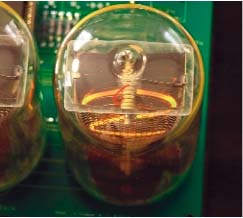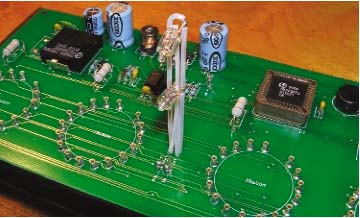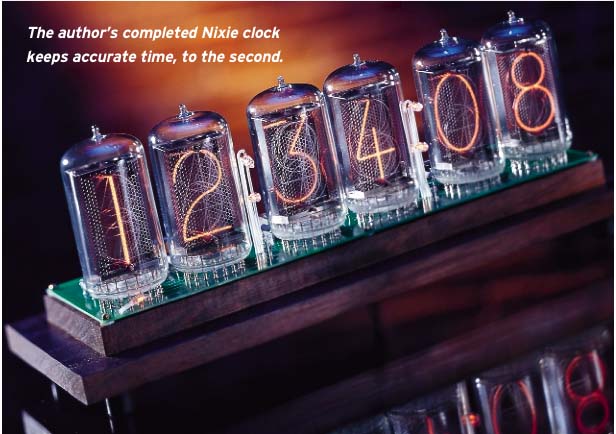

DO IT YOURSELF
A Clockwork Orange A web archive of the printed article published by the IEEE for Spectrum magazine, July 2003 .
In which the author builds a GPS-controlled Nixie-tube timepiece
BY PAUL WALLICH
"Hmm," says Jeff Thomas, "I've never had one fail like this before." Even over the phone, his voice carries the fascination of an engineer faced with a new problem to solve. Left unsaid by both of us is the thought that "only a reporter could screw up a simple soldering job like this."
I'm building a Nixie-tube clock [photo, right] from a kit-a design by Thomas, a test-equipment engineer in Mesa, Ariz., and electronics enthusiast John Miktuk. Thomas supplied the circuit board and other components as part of the US $259 kit I ordered from his Web site (clockpage.html), but not the Nixies. For those, he referred me to German radio collector-turned-surplus-supplier Jan Wuesten in Ramstadt, who sold me six 100-mm-high Nixie tubes originally intended for clocks in East German railway stations.
The Nixie is perhaps the apogee of the tube maker's craft, invented a few years after the transistor and produced in quantity until the late 1970s. Each glass tube typically contains 10 or more individual cathode wires in the shape of numbers or letters, along with a common anode and a mix of neon and other gases that glows orange just around a cathode when a potential of 100 V or more is applied to the tube.

The half-dozen tubes arranged on my worktable are, literally, giants among their fellows. Within each tube stand 10 photo-etched cathode numerals 50 mm high, all wrapped in a hexagonal filigree of anode a fraction of a millimeter thick. You can get them in clear glass as I did.
A small industry has sprung up around surplus Nixie tubes. Thousands of Web sites tell the story of the tubes, catalog the myriad models, and describe clocks and other displays you can build with them. Contributors exchange reminiscences, construction tips, and speculation via mailing lists, and dozens of tube-containing gizmos and tube lots are up for auction on eBay at any given moment.
It's
GPS time
The time for Thomas's clock
is delivered in the signal from U.S. Global Positioning System (GPS) satellites
passing overhead. Each satellite contains an extremely accurate atomic clock,
exact to billionths of a second or better, and is carefully tracked in its orbit.
It transmits time and position signals so that receivers near the ground can
determine their location by calculating their distance to several satellites.
The GPS receiver attached to my circuit board was originally designed for cellphones. It decodes the data, which contains the date as well, and sends it out a serial port. The decoded GPS signal passes from the receiver to a microcontroller, which determines how to display the time. A serial bit stream coming from the microcontroller passes into a pair of 32-bit high-voltage serial-to-parallel drivers and comes out as 64 control signals that light up the appropriate cathodes of the Nixie tubes. Every second, the microprocessor kicks a new 64-bit signal out to the drivers and latches them to display the time.
Simple.
Putting
it all together
The eight pages of single-spaced,
carefully illustrated directions start with a warning that voltages used in
the clock can kill you if you play with the circuit while it's plugged in. They
continue with an admonition that the kit is not for people assembling their
first electronics project.
 |
 |
But for anyone who knows what they're doing, assembling this clock is straightforward. You start by slipping 102 tiny sockets onto the pins of the six giant Nixies, aligning them in holes in the circuit board and filling the holes with solder. Pull the Nixies from these new custom-fitted mounts and put them in a safe place. Then progress to three 44-pin chip carriers and a few dozen resistors, capacitors, and diodes. To separate the hours, minutes, and seconds, you'll need to fabricate a couple of colons out of piano wire, neon lamps, and Teflon insulation. That's about it. The soldering, trimming, and socketing add up to about a weekend's labor if you have nothing else to do from dawn till dusk.
Tall
tube tales
For many who populate Nixie-tube
mailing lists, this kind of production work is old hat. Nixie art pioneer Raymond
Weisling, for example, has been building Nixie and neon art since the 1970s,
when he built a four-letter word generator out of segmented Nixie alphanumeric
displays taken from stock tickers. Perhaps that's why chats so often turn to
the next level of wizardry: building Nixies from scratch.
Getting a wire to glow inside a glass envelope is easy. Getting 10 hair-thin wires bent in different shapes and spaced a fraction of a millimeter apart to glow independently is harder, and getting them to glow reliably for 10 000 or 100 000 hours of continuous service is harder yet. Much of the expertise needed to build tubes reliably and in volume has been lost as the original engineers died or retired. Aspiring tube makers have to figure out such details as the composition of electron-emission-enhancing coatings; the precise mix of neon, argon, and mercury vapor required for a stable glow; and how hot and how long to bake tubes under vacuum to get rid of surface contaminants. And that's even before the question of how much radioactive thorium to put in each tube to reduce ionization thresholds.
Why bother? Ample supplies of surplus Nixies are still available, for prices as low as $5-$10 each. Thomas, for instance, just bought a 15 000-tube lot for a new, streamlined clock kit.
And, of course, although 15 000 tubes may be enough for a third of a million dollars' worth of retro clocks, it's only a few days' or weeks' worth of production for a real vacuum-tube assembly line-which may explain why Richardson Electronics Ltd. (La Fox, Ill.), the only company reported to still have the tooling for making Nixies, hasn't restarted its line.
Solder,
solder everywhere
I finish soldering
my clock, snap the microcontroller and the drivers into their sockets and ease
the Nixies into theirs, attach the GPS daughterboard and antenna, and power
it up. The speaker chimes, a status LED starts blinking good news, and the Nixies
start flashing on their way to displaying a good signal. Then they all lock:
"11:11:11"-a beautiful orange glow in the half-darkened room. But it's not right.
A call to Thomas-he's in his office on his birthday-and here I am with a multimeter, probing voltages and continuity all around the circuit. The high-voltage lines are O.K., the microcontroller appears happy, but clearly what the drivers are putting out is not the orderly parallel array of bits the tubes were expecting.
Usually, troubleshooting calls take five minutes or so, Thomas says, but I've managed to do something new to his kit. Most likely, we agree after about 35 minutes of poking at various pins, I've managed to create a solder bridge under one of the chip carriers, shorting some pins together, and terminally confusing either the drivers or the output side of the microcontroller.
I box the board, sans Nixies, and send it to Thomas, who has a multichannel oscilloscope to confirm the diagnosis and a small solder pot to free the chip carriers safely from the circuit board. It turns out I shorted two data lines to nearby high-voltage cathode lines, one on the front of the board under a chip carrier, the other just eluding my eye on the back. Remarkably, the driver chips are unfazed by having 100+ V applied to the wrong pins.
Time
told
Thomas takes a couple of
days to clean up my mistakes and returns the board, graciously replacing a microscopic
reed switch that I cracked while trying to diagnose the clock's strange initial
behavior.
The working clock fits nicely under the acrylic cover on the custom-fitted walnut mounting plate (also available from Thomas for $69). It's a splendid marriage of old and new: 50-year-old vacuum technology glowing silently under the influence of up-to-the-minute semiconductors and a constellation of satellites orbiting thousands of kilometers above me.
To Probe Further
The kit I built, along with several of Thomas's other creations and kits, can be seen at clockpage.html. My kit cost US $259 ($288 with two-day shipping in the United States). Thomas can be found in the physical world at 100 W. Hoover Ave., Suite 3, Mesa, AZ 85210; phone, +1 480 898 1195; fax, +1 480 898 1215.
For a look at other Nixie clocks, see "New Life for Nixies" by Glenn Zorpette, IEEE Spectrum, June 2002
PHOTOS: JIM WESTPHALEN / PAUL WALLICH